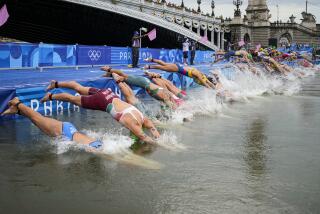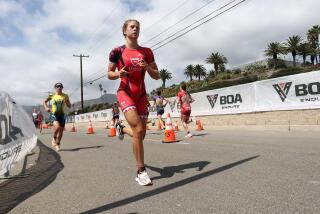Triathlons Drawing More Iron Women : Sports: Many aren’t as interested in high-intensity contests as they are in meeting and training with other sports-minded people and competing on their own level.
- Share via
MEDFORD, Mass. — It’s not enough just to be a good swimmer or a competitive bike racer or a long-distance runner. To be a triathlete, you must be all three. And two of every 10 such all-around athletes today are women.
Of the 490 triathletes who participated in the 10th anniversary Bay State triathlon in Medford, Mass., a long-distance triathlon, only 44 were women. But in one of the newest and toughest tests of athletic ability, the number of female competitors is steadily getting larger, particularly in shorter races, says Lew Kidder, co-publisher of Triathlon Today magazine.
According to Kidder, women are looking for more than “a macho event.” Most women who enter triathlons are not as interested in high-intensity competition as they are in the opportunity to meet and train with other sports-minded people, compete on their own level, and, as one devoted triathlete says, “find out how much they can do.”
Karen Smyers, winner of last fall’s Bay State triathlon and the Danskin Women’s Triathlon in June, is at 29 years old a National Champion and International Triathlon Union World Champion. Shorter races are not as rewarding financially as some larger events: A national series race winner might receive between $1,000 and $10,000; the male and female winners of the Hawaiian Ironman each receive $20,000. The top five finishers in Medford shared about $2,000 among them.
But Smyers tries to race the shorter ones as often as possible to show support for triathlons and the women who are trying them for the first time.
“I think it’s important that the elite (professional) women take part . . . to be role models and motivate the girls to stick with it and give them something to shoot for,” she said.
The triathlon--a swim, bike, and foot race of varying distances--has come a long way since the first Hawaiian Ironman Triathlon in 1978. That grueling race, consisting of a 2 1/2-mile swim, 112-mile bike ride, and 26.2-mile run (marathon distance) inspired a number of athletes to take up the sport, says Smyers.
Still, “unless you’re a nut case,” watching an Ironman race does not inspire the average athlete to compete in one, Smyers said.
“For every one Ironman, there are 50 shorter races that are so much more suitable for most people,” Smyers said.
Many of the shorter races are Sprint distance (less than 1/2-mile swim, 15-mile bike ride, 3 1/2-mile run), Olympic distance (1 1/2-kilometer swim, 40-kilometer bike ride, 10-kilometer run), or international-distance races (anything longer than a Sprint).
The number of women competing in shorter triathlons is growing, said Tim Yount, spokesman for the Triathlon Federation/USA, the national governing body for triathlons and biathlons (two-event races). Yount estimates that five or six years ago only 15% of triathletes were women; that figure is now about 20%.
“Women are becoming more involved and more vocal in the sport,” he said. “They’re saying, ‘Let’s try to do these things so we can benefit women athletes all over the country.”’
Smyers, a Princeton University graduate and former computer consultant, began competing professionally in 1984. She said American women already have an advantage over many of the European women racers:
“In those countries, only 5%, maybe less, of the field will be women. In some cultures, women aren’t supposed to sweat and be fit and spend time on such things. Here, people will see a woman out running and think she looks beautiful.”
Still, it’s important to get girls involved, Smyers said. In the Danskin race, 12-year-old Katy Radkewich of Hudson, Ohio, held her own against some of the top racers and finished first in her age group, 40th overall out of 750 racers. “We’ve got to have more meets out there for girls to compete in--to get them used to seeing themselves as both athletic and competitive,” Smyers said.
But triathlons are gaining ground not only among younger women. Margaret Regina, an amateur triathlete from Reston, Va., raced her first full-distance triathlon two years ago at age 50--”a time when most people start to slow down,” she said. Regina started doing triathlons at the urging of some friends, and stuck with it because she found a built-in support system among her racing peers.
Smyers said that most of the women involved in triathlons are not laid-back, nor do they race simply because they love being outdoors.
“Most of the women are interested in how well they’re doing against their competitors and in improving their times,” she said. “In a road race you might find some people out simply for a jog or just to take part in something. I wish more triathletes would do it just to participate.”
Beth O’Connor, a 30-year-old teammate of Regina’s on a Masters swim team in Reston and a former varsity swimmer at the University of Virginia, said that women who participate in triathlons tend to be “driven, successful, and competitive.” O’Connor said many women like herself started doing triathlons out of the feeling that they needed to do something for themselves and even to prove something to themselves.
“I try to keep it (triathlon training and competition) in perspective,” she said. “I know people who have gotten divorced over triathlons because they devote so much time to it. I like to think I have other things in my life.”
O’Connor said she prefers the shorter races because they are easier to train for and she is less likely to lose interest. She usually trains six days a week for several hours a day, but says she’s gotten to the point where she isn’t concerned about missing a day here and there. Kidder of Triathlon Today says he believes that most women prefer shorter races because the training fits in better with a multifaceted lifestyle.
Smyers said that if a woman is to be successful as a triathlete and continue to enjoy the sport, she must learn to relax and not take the pressure too seriously. Smyers had to find this out for herself after not doing as well as she would have liked in her first few years as a professional triathlete.
“I had to stop spinning my wheels and trying so hard that I wasn’t going anywhere,” she says. Judging from the smile on her face as she led the pack out of the water at the Bay State races, she’s learned to do just that.
Smyers competed in her first triathlon in 1984 on an old, beat-up bike she used for commuting to work. She didn’t do very well in that race and was frustrated knowing that she could have done as well or better than some others if only she’d had better equipment.
But today, when Smyers sees athletes spend $3,000 on racing equipment before they’ve entered their first triathlon, she’s even more frustrated. “It’s just not necessary,” she said.
Yount said most recreational triathletes might spend, say, $1,175 initially: $200 for a wet suit; $10 for goggles; $800 for a bicycle; $40 for a helmet; $70 for bike cleats; and $55 for running shoes. But really, “the sky’s the limit,” he said.
Kidder is more conservative in his estimate of a triathlete’s basic needs. There’s often a big difference between what triathletes need and what they perceive they need, he said. Those who go to a triathlon with a swimsuit, goggles, a $400 bike, a helmet, and running shoes will have all they need, he says. The problem is, these athletes will look around and conclude that they can’t possibly compete.
What they’ll see, among other things, are $1,500 bicycles equipped with special aerodynamic handlebars ($60) and racing wheels (up to $250 each) or even special “disc” wheels (best for speeds over 24 m.p.h.) costing $300 to $400.
“This equipment not only can make a difference, it can be perceived to make a difference--and that’s the rub,” Kidder said.
An unavoidable cost is a steep entrance fee: about $40 to $50 for the average race. This covers such expenses as city services, insurance, publicity, T-shirts, buoys, aid stations, and lifeguards.


